New York Loan Agreement
This Loan Agreement is made on [Date] between the following parties:
- Lender: [Lender's Full Legal Name]
- Address: [Lender's Address]
- Borrower: [Borrower's Full Legal Name]
- Address: [Borrower's Address]
This agreement shall be governed by the laws of the State of New York.
The parties agree as follows:
- Loan Amount: The total amount of the loan is [Loan Amount].
- Purpose of Loan: The Borrower will use the loan for [Purpose].
- Interest Rate: The loan will bear interest at an annual rate of [Interest Rate].
- Repayment Schedule: The Borrower agrees to repay the loan as follows:
- Commencement Date: [Start Date]
- Due Date: [Due Date]
- Payment Amount: [Payment Amount]
- Late Fees: A late fee of [Late Fee Amount] will apply if the payment is not received by the due date.
- Prepayment: The Borrower may prepay the loan without penalty.
- Default: If the Borrower defaults on this agreement, the Lender may take appropriate action to collect the amount due.
- Governing Law: This agreement shall be interpreted and enforced in accordance with the laws of the State of New York.
By signing below, both parties acknowledge that they have read and understand this Loan Agreement.
Lender Signature: ________________________ Date: _______________
Borrower Signature: ______________________ Date: _______________
